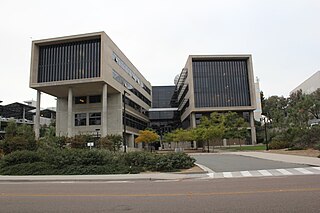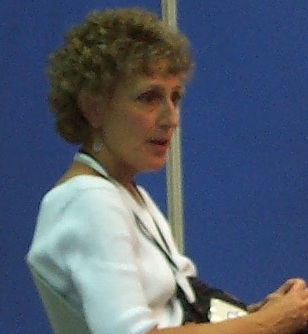Related Research Articles

Max Vernon Mathews was an American pioneer of computer music.

The San Diego Supercomputer Center (SDSC) is an organized research unit of the University of California, San Diego (UCSD). SDSC is located at the UCSD campus' Eleanor Roosevelt College east end, immediately north the Hopkins Parking Structure.

TeraGrid was an e-Science grid computing infrastructure combining resources at eleven partner sites. The project started in 2001 and operated from 2004 through 2011.
The Corporation for Education Network Initiatives in California is a nonprofit corporation formed in 1997 to provide high-performance, high-bandwidth networking services to California universities and research institutions. Through this corporation, representatives from all of California's K-20 public education combine their networking resources toward the operation, deployment, and maintenance of the California Research and Education Network, or CalREN. Today, CalREN operates over 8,000 miles of fiber optic cable and serves more than 20 million users.

Larry Lee Smarr is a physicist and leader in scientific computing, supercomputer applications, and Internet infrastructure from Missouri. He currently works at the University of California, San Diego. Smarr has been among the most important synthesizers and conductors of innovation, discovery, and commercialization of new technologies – including areas as disparate as the Web browser and personalized medicine. In his career, Smarr has made pioneering breakthroughs in research on black holes, spearheaded the use of supercomputers for academic research, and presided over some of the major innovations that created the modern Internet. For nearly 20 years, he has been building a new model for academic research based on interdisciplinary collaboration.
Thomas Albert "Tom" DeFanti is an American computer graphics researcher and pioneer. His work has ranged from early computer animation, to scientific visualization, virtual reality, and grid computing. He is a distinguished professor of Computer Science at the University of Illinois at Chicago, and a research scientist at the California Institute for Telecommunications and Information Technology (Calit2).
James D. Hollan is professor of cognitive science and adjunct professor of computer science at the University of California, San Diego. In collaboration with Professor Edwin Hutchins, he directs the Distributed Cognition and Human–Computer Interaction Laboratory at UCSD, and co-directs the Design Lab. Hollan has also spent time working at Xerox PARC and at Bellcore. He was elected to the CHI Academy in 2003 and received the ACM SIGCHI Lifetime Research Award in 2015.

The Donald Bren School of Information and Computer Sciences, also known colloquially as UCI's School of ICS or simply the Bren School, is an academic unit of University of California, Irvine (UCI), and the only dedicated school of computer science in the University of California system. Consisting of nearly three thousand students, faculty, and staff, the school maintains three buildings in the South-East section of UCI's undergraduate campus, and maintains student body and research affiliations throughout UCI.

Maxine D. Brown is an American computer scientist and retired director of the Electronic Visualization Laboratory (EVL) at the University of Illinois at Chicago (UIC). Along with Tom DeFanti and Bruce McCormick, she co-edited the 1987 NSF report, Visualization in Scientific Computing, which defined the field of scientific visualization.

The California Institute for Telecommunications and Information Technology (Calit2, previously Cal(IT)2), also referred to as the Qualcomm Institute (QI) at its San Diego branch, is a $400 million academic research institution jointly run by the University of California San Diego (UC San Diego) and the University of California, Irvine (UCI); in January 2022, plans were announced to add University of California, Riverside to the consortium. Calit2 was established in 2000 as one of the four UC Gray Davis Institutes for Science and Innovation. As a multidisciplinary research institution, it is conducting research discovering new ways in which emerging technologies can improve the state's economy and citizens' quality of life. Keeping in mind its goal of addressing large-scale societal issues, Calit2 extends beyond education and research by also focusing on the development and deployment of prototype infrastructure for testing new solutions in real-world environments. Calit2 also provides an academic research environment in which students can work alongside industry professionals to take part in conducting research and prototyping and testing new technologies.

The California Institute for Quantitative Biosciences (QB3) is a nonprofit research and technology commercialization institute affiliated with three University of California campuses in the San Francisco Bay Area: Berkeley, San Francisco, and Santa Cruz. QB3's domain is the quantitative biosciences: areas of biology in which advances are chiefly made by scientists applying techniques from physics, chemistry, engineering, and computer science.

4K resolution refers to a horizontal display resolution of approximately 4,000 pixels. Digital television and digital cinematography commonly use several different 4K resolutions. In television and consumer media, 3840 × 2160 with a 16:9 aspect ratio is the dominant 4K standard, whereas the movie projection industry uses 4096 × 2160.
The Center for Research in Computing and the Arts (CRCA) was an interdisciplinary organized research unit of UCSD in San Diego, California. CRCA provided support for numerous projects that intersect with the fields of New Media Art, Software Studies, Game studies, Art/Science collaborations, Mixed Reality, Experimental Music, Digital Audio, Immersive Art and Networked Performance over its 40 year history. CRCA was originally founded by composer Roger Reynolds as the Center for Music Experiment (CME) in 1972, and was directed for many years by F. Richard Moore. The center was renamed and the scope widened when artist and artificial intelligence pioneer Harold Cohen became Director in 1993.

Elle Mehrmand is a new media performance artist and musician. Mehrmand's work combines the body and electronics. Her performance art work has been presented at museums, galleries and art festivals throughout the Americas. She is a member of the band Assembly of Mazes.

Sheldon Brown is an American artist and former Professor of Computer Art at the University of California, San Diego where he held the John D. and Catherine T. MacArthur Foundation Endowed Chair of Digital Media and Learning. He was the founding director of the Arthur C. Clarke Center for Human Imagination at UCSD, a co-founder of the California Institute of Information Technologies and Telecommunications, where he was Artist-in-Residence, and he was the site director of the Center for Hybrid Multicore Productivity Research at UCSD. He has been a Visiting Arts Professor at NYU Shanghai, an Honorary Professor at Shanghai University and Professor and Research Leader at the Creative Computing Institute, University of the Arts London. His work examines the relationships between mediated and physical experiences.

Doremi Laboratories, Inc., often shortened to Doremi Labs, was a developer and manufacturer of digital servers and format converters for the digital cinema, broadcast, post-production and professional A/V markets. It was established in 1985 in Burbank, California, United States, and was absorbed into Dolby Laboratories in a 2014 acquisition.

Jane de Almeida, born in Para de Minas, Brazil, is a researcher, director, artist, curator and theoretician.

Ilkay Altintas is a Turkish-American data and computer scientist, and researcher in the domain of supercomputing and high-performance computing applications. Since 2015, Altintas has served as chief data science officer of the San Diego Supercomputer Center (SDSC), at the University of California, San Diego (UCSD), where she has also served as founder and director of the Workflows for Data Science Center of Excellence (WorDS) since 2014, as well as founder and director of the WIFIRE lab. Altintas is also the co-initiator of the Kepler scientific workflow system, an open-source platform that endows research scientists with the ability to readily collaborate, share, and design scientific workflows.

Eric R. Williams is an American screenwriter, professor, cinematic virtual reality director, and new media storyteller. He is known for developing alternative narrative and documentary techniques that take advantage of digital technologies.
References
- ↑ "RNP realiza a transmissão de cirurgias em 4K". EXAME (in Brazilian Portuguese). Retrieved 2020-02-06.
- ↑ "CineGrid: A New Cyberinfrastructure for High Resolution Media Streaming". CTWatch Quarterly. May 2007. Archived from the original on 23 July 2011. Retrieved 21 April 2011.
- ↑ "2008 ORION Discovery Award Recipient" (PDF). The Ontario Research and Innovation Optical Network. 2008. Archived from the original (PDF) on 24 July 2011. Retrieved 21 April 2011.
- ↑ "CineGrid@AES Special Event" (PDF). San Francisco State University. 25 October 2006. Archived from the original (PDF) on 12 June 2010. Retrieved 21 April 2010.
- ↑ "CineGrid: Super high definition media over optical networks". Science Direct . 2011. Archived from the original on 2 February 2013. Retrieved 21 April 2011.
- ↑ "CineGrid Demonstrates International Networked Distribution of 4K Motion Pictures". TransLight/StarLight Press. 25 October 2007. Retrieved 21 April 2010.
- ↑ "Calit2, CineGrid Win CENIC Award". Digital Cinema Report. 2011. Retrieved 21 April 2011.
- ↑ "Calit2, CineGrid Win CENIC Award". Digital Cinema Report. 2011. Retrieved 21 April 2011.
- ↑ "Hiperwall software video wall uses normal PCs and monitors". gizmag. 18 February 2010. Retrieved 21 April 2011.
- ↑ "SAGE News". Electronic Visualization Laboratory. November 2008. Retrieved 21 April 2011.
- ↑ "Cinema technologies have scientific applications". FAPESP Agency. 8 October 2014. Retrieved 18 November 2014.
- ↑ "CineGrid: cinematic futures". ResearchGate . 4 May 2018.